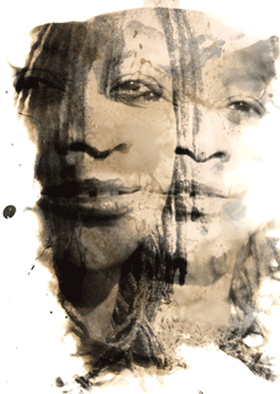
| Anarcha Project |
The Olimpias Performances Research Projects
|

The Anarcha Project: Sims and the Medical Plantation
The Anarcha Anti-Archive, with Remembering Anarcha: Objection in the Medical Archive, historical background project essay, published in Liminalities, 4:2, 2008.
Cyber Participant Instructions for Symposium
The Anarcha Symposium DVD is now available! Contact us for a free copy.
Core Collaborators for the Anarcha Project: Petra Kuppers, Anita Gonzalez, Carrie Sandahl, Tiye Giraud, Aimee Meredith Cox
The Anarcha Project is a collaborative performance project that evokes haunting memories of three Alabama slave women who in the 1840s persevered through years of medical experimentation at the hands of J. Marion Sims, “the father of gynecology.”
We resurrect the memories of Anarcha, Lucy, and Betsy through performance material developed out of two years of archival research as well as live and on-line workshops with hundreds of writers, artists, performers, activists, academics, and students. The workshop participants’ responded to these women’s stories with remembrances both imagined and real.
With its infusion of dance, spoken-work poetry, theatre, music, and projected images, The Anarcha Project celebrates folkloric healing practices, explores ethical relationships to history, and interrogates the on-going abuse of marginalized people in health care practices today.
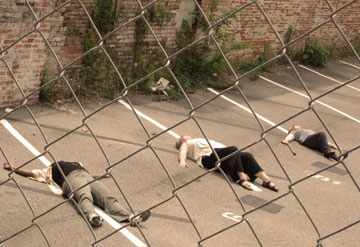
(scene from workshop in Montgomery, Alabama, at the parking lot that is the original site of the slave hospital. Other images below are from this site or from the Auburn University Montgomery, who kindly gave us the use of their theatre for our work)
In 2006/7, we ran a number of residencies at different sites: Ann Arbor, Michigan; UC Berkeley, California; Davidson, North Carolina; Mongomery, Alabama; Seattle, Washington.
A 3-to-10 day investigation with students, faculty and community members, culminating
in a shared performance.
As part of the performance
package or separately, we offered practical workshops in:
Visual Practices for the Stage
Installation and Performance
Developing Text
Theatre Movement, Voice and Sounding
Access and Performance
We also offered contextual
seminars in thematic areas such as:
African-American Social and Political History
Disability Culture
Medical History and Issues of Inequality
Representations of Pain and Trauma
We also offered public lectures
in those thematic areas, with specific material on:
The Anarcha Project
The Tuskegee Syphilis Project
The Hottentot Venus
Eugenics and Disability
Slave Narratives and Gender.
Example of Workshop Show Material
created in the residencies (version from May 2006, Montgomery, Alabama)
The Anarcha Project: J.
Marion Sims and the Medical Plantation
By The Olimpias
Material created in 2006.
This material is Open Source, and held in creative commons rather than copyright. You may use it, but please acknowledge its origin.
Petra Kuppers, Anita Gonzalez, Carrie Sandahl and
Tabitha Chester
gratefully acknowledging input by community members
Cast Note: Cast Numbers, Positions or Characters are not fixed. Three+ people can perform these acts of remembrance and analysis.
Scene: Years Passing…
To Bear (sung by all members
of cast)
We all have our crosses to bear
And our little dresses to wear
Heaven lasts always
but no man has ever seen
(The song continues, half-hummed, handheld, circle-held, hugging middles, rocking
backwards and forth, holding on.)
(Projection/Narration,
intersected by images of Montgomery, Alabama, and other Sims statues in NYC,
South Carolina, other Alabama towns, and images of slave life in the 1840s and
50s)
1846: Montgomery doctor J. Marion Sims pays to build a hospital with 16 beds
in his backyard. He was setting out to find an operative cure for women's fistula,
openings between the bladder and the vaginal or rectal region, often caused
by prolonged childbirth - a relatively common condition that made women incontinent.
Sims asked plantation owners to provide him with subjects, slave women. In the following 3 years, Sims worked on up to 11 patients at a time.
We only know 3 names: ANARCHA, BETSEY and LUCY. Sims tells in his biography that he operated on ANARCHA more than 30 times. He did not use anesthesia for the operations on their vaginas, but he used opium to aid with recovery. His development of the speculum made him the first modern doctor to actually look at and into women's vaginas.
We know nothing about the women, about whether they were cured, where they went, when they died. Later, Sims used the methods and instruments he developed to become the celebrated and well-traveled 'father of gynecology'.
Scene: This is not about
Sims
The SIMS Song (excerpt)
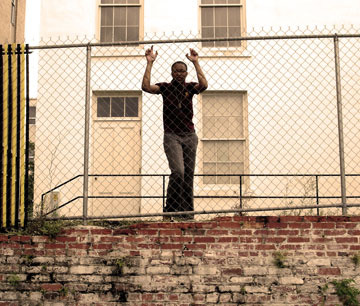
Solo Voice and Chorus (rest
of cast)
There's a SIMS monument.
In Montgomery. Right here
I just start laughing
I just shudder and clench
Speculating with the Speculum
Why would you want to talk about that, write about that, think about that.
He's a rural doctor with
an inspiration.
He has an aspiration
He finds exaltation in the demonstration
Of experimentation
His medical theatres have become macabre.
Wooden cabins Glass dildos. Cut vaginal walls.
Black slave women like me
For experimentation
Betsey and Lucy and …Anarcha
Black woman
I want to imagine her as
a resistor, but I don't think so. Most Alabama folks know how not to be resistors.
After all, where could you go.
Can't run.
Can't move.
's in the silence of no
talk. ------No
in the fear to speak. ------No
one remembers. ------ No
action, ------ No
reparations. ------ No
one cares. ------ No
The pewter spoon speculum
Finding the Fistula
Finding the origin of
The vaginal tear
The Stink that makes
An outcast,
A freak crip
A Nazi non-human T4
NWL - Not worth living
Marion Sims
The father of gynecology.
The shudder and the arrest.
[Exhalation]
The shudder and the arrest.
Scene: Perspectives/Fantasies/Fetishes of History
(Projection
combined with images)
It takes less than 30 minutes to travel from the site of the hospital in Montgomery,
on Perry Street, to Tuskegee, the site of the Syphilis Study where poor black
men were left untreated and uninformed in a government-sponsored health experiment.
(Sound Poem, while stage action: one performer creates an arrangement of two cots, a desk, a book, a chair, [if stage permits:] wet blankets, a few moving bodies. Each arrangement of the hospital is held, then dissolves and someone else guides the furniture and bodies into new fantasies of what it might have been like. Tensions: furniture dragging on the floor, get in the way)
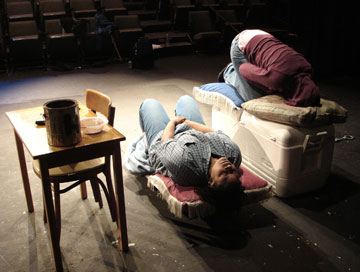
Blot
Blot
Blot
Spreading
Dripping
Spreading
Searing
Pinching
Shushing
Stiching
Blot
Blot
Blot
Pulling
Shushing
Shushing
Haze
Scene: Hunting Shadows
(Movement Sequence, with choreography based on tracing one's own shadow on the
ground, intersecting with other shadows, meetings, encounters, whisperings into
body hollows. [jf stage permits:] wet stains from dripping blankets create holes
in the moving coverage of the stage)
Projection: Shadow/Texture Sequence
Sound: Humming

Scene: Rituals
(The song words are both sung, and also projection in the shape of a cross.
Stage action: a circle dance emerging from a hospital cot, combining Afro-Christian
and Yoruba material)
The Blood
The blood
Wash in the Blood
Of Jesus Christ
The Blood that drips
From me can never be washed all that clean
Ask the Lord and he shall make you white as doves
My help comes from the lord
He shall provide all my strength
If I ask
Scene: Healing Garden Fantasy
(light change,
projection: gardens, quilts, patterns, images of gardens in performance location,
window sill life, and other comforts of making a home)
Dance Sequence
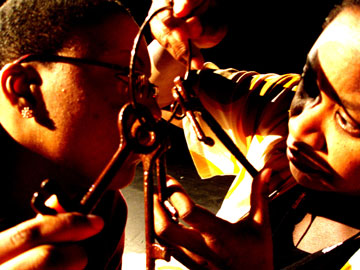
Scene: To Feel No Pain
(This scene changes with local voices, workshop participants, who deliver spoken
word directly to the audience.
To the side: one performer wrings out wet blankets over buckets, again and again)
(Projection,
also intersected with other images, including emergency room waiting areas and
other contemporary medical scenes)
"The question of anesthesia is also broached. Sensation in the upper vagina,
especially in areas that have been rendered fibrotic from chronic infection,
are substantially less sensate than, for example, the skin. Therefore, the manipulation
of the fistulae would not have produced the same type of discomfort as an incision
made through a fistula that exited through the dermis" (O'Leary, 2004,
Journal of Southern Medicine, 427).
To Feel no Pain
Something about eating potato chips and feeling no pain because after all black
people have a disease where they don't feel pain. They just experience it: which
is somehow different from white people feeling pain and really suffering through
it.
So when Black people have diarrhea or diabetes or just plain amputations. Or get their teeth pulled out with forceps, they don't really feel it. They just add it onto the rest of their experiences of slavery and rape so that they can have great survival stories. And songs like (sing) "Up from a past rooted in pain, I rise."
I am really happy to hear they have a name for this affliction. Dysaesthesia Aethiopis. And that it is a disease. Dysaesthesia Aethiopis. It sounds just like a blues song or a spiritual chant, nice and (aesthetic)/(anesthetic) because it alleviates the afflictions of living. And this is what I would need to pretend to forget the pains of the past as I move through the pains of the future. Because I am definitely looking forward to experiencing Katrina and AIDS and the criminal system, and even the hypocrisy of black middle class backlash in a state of Dysaesthesia Aethiopis.
To Feel No Pain
Montgomery will not give up her secrets easily.
Pouring rain
Whitewashes the shotgun shack.
Good old boys celebrate her fruits with their music.
Are we asking her to betray
the secrets of a patient,
Prying pewter spoon
spoons history where she feels no pain.
A collective dysaethesia aethiopis obscures memory.
Her crooked finger dangles
the key,
Drawing us near.
Gossip in the town
the stain spreads revealing as it obscures.
Hush in the blanket.
Eating bits of straw,
Unravel the threads in the candlelight
The candle drips wax and casts shadows on the wall.
To Feel no Pain
I know a woman who lives in a shelter.
She is a domestic violence survivor.
She knows being beaten.
She knows running away.
She knows staying.
She knows shame.
Not to be believed, told what to do, counting her bills.
She knows.
She knows the repetition of the fist on her face, the boot in the gut, the money
that she needs, her children need, the roof, the tile of the bathroom floor.
And she tells me:
I know I should take it.
Take it like a woman, rooted in pain.
Do not give in to the shame.
Rise from the pain.
Makes me strong.
I know.
'Dyaesthesia aethiopis' - black people feel no pain.
That's what racist science knew, without shame,
and they use the pain to perpetuate the institution,
the corporation, the factory machine of slavery.
Black people can work in this heat.
They can take malaria, the scratch of the mosquito bite, the bite of the whip.
The scientists knew, no shame.
And knowledge infects, infiltrates, mutates, survives, incorporates, draws the
line.
Cancerous, white shapeless cells sucking blood.
Infection, defection, inflection: the case of pain is declinated, put through
its paces, the Latin phrase infecting the rule of the plantation.
The slaveholders know no pain, no shame.
They knew what to say.
They knew that the cotton dress they wore on their Scarlet skin was made by
people, people I say,
people who knew no pain, who knew that the fist and the boot knew them, and
would know them again.
Sims cut
took the cut
knowing what they all knew,
the public secret of pain: no pain, no shame, and lots of gain.
Scarlet lives in a shelter now,
knowledge has reached the last line,
the last entry in the family tree of blood relations,
blood vessels,
blood vassals,
bowing to the people who know blood:
the scientist, the foot in the boot, the man infiltrated by the shame of slavery.
Sitting for hours in the emergency room, the last line of health care for the
uninsured, the pain, the shame, no gain, no money ….
The pain is a sore, a fester of bites, a plantation souvenir,
remembering the infection of the US of A,
the reaction of the US of eugenics,
the perfection of Nazi science,
of knowing the blood.
Blood speaks and sings,
behind black skin, white skin:
of diabetes, HIV, arthritis, of sickle-cell and of
a tension, a tension, a tension that pushes, and throbs.
To know the blood is to make the money, to feed the industry, no shame,
the medical plantation,
the corporation,
the amalgamation of Pfizer, Bayer, Bristol-Mayers.
Scene: Ending
(in this scene, song and movement merge into a touching, a farewell, a letting
go)
To Bear (sung by all members
of cast)
We all have our crosses to bear
And our little dresses to wear
Heaven lasts always
but no man has ever seen
Biographies (Artists for Montgomery, Alamaba, Residency)
Petra Kuppers
Petra Kuppers is Associate Professor in English, Theatre and Women's Studies
at the University of Michigan, Ann Arbor, and Artistic Director of The Olimpias
Performance Research Series.
She is the author of Disability and Contemporary Performance: Bodies on Edge
(Routledge Press, 2003), and The Scar of Visibility: Medical Performances and
Contemporary Art (University of Minnesota Press, 2007), Community
Performance: An Introduction (Routledge, 2007). She is also the editor of Disability
and Performance (Harwood Press, 2001) and Disability Culture (Disability Studies
Quarterly, 1999), and co-editor (with Gwen Robertson) of Community Performance:
A Reader (Routledge, 2007).
Petra works internationally as a Disability Culture Activist and Community Performance
Leader. She has received many honors for her disability culture work in Europe,
the US, New Zealand and Australia, including the Inaugural Caroline Plummer
Fellowship in Community Dance, awarded by the University of Otago, New Zealand,
2005. Her award-winning work includes Earth Stories and Sleeping Giants, two
videos created with mental health system survivors that use myth and local legends
as starting points for a new vision of mental health difference, Geometries
and Scar Tissue: A Body of Work, two dance/performance videos that focus on
the interplay of human bodies and their environments, Tracks, a digital photography/creative
writing exhibit and retake of landscape art through a disability perspective,
and Coastal Mappings, an intercultural performance event with people focused
around a New Zealand hospice. The UK National Endowment for Science, Technology
and the Arts, Chisenhale Dance Space, the UK Millennium Commission, the Lisa
Ullmann Foundation, Ausdance and DANZ (the national dance organizations of Australia
and New Zealand), the Rhode Island Foundation and the Rhode Island Council for
the Arts are some of the institutions that have funded her research and practice.
Her visual arts work has been displayed in galleries and museums in Germany,
UK, US and New Zealand, and she had been supported through residencies from
the Arts Council of Wales, New Pacific Studio, The Mesa Refuge, and many other
arts organization and residency centers.
She is an advisor on the current 3-year study of Careers in the Arts for People
with Disabilities from the National Endowment for the Arts, and she builds infrastructure
for community artists through the organization of professional development series
and international conferences (Praxis and the Body, 2000; Community Performance,
2004; and Sedimentations, 2007).
In 2006 Petra works as a Fellow at the Institute of Medical Humanities, University
of Texas Medical Branch, to pursue further studies on Sims and the nexus of
questions opened up by his practice. The material gathered during this fellowship
and in this residency series will contribute to her new study, entitled Affective
Movement: Dance, Disability History and Storytelling.
Anita Gonzalez (Collaborator)
Anita Gonzalez is an Associate Professor in the Department of Theater Arts
at the State University of New York - New Paltz where she teaches Directing,
African American Drama, and Race Gender and Performance. Her research interests
are in African American performance, Latin American and Indigenous Theater,
and popular culture. She has lectured in Europe, Latin America, and throughout
the United States at universities, arts centers, community centers, and in the
public schools.
Gonzalez is also a director, choreographer, and performer, and she was a founding member of the Urban Bush Women. Jennifer Dunning of The New York Times describes Ms. Gonzalez as "a vibrant, powerful stage presence." Her work has appeared on PBS national television (Conjure Women) and at Lincoln Center Out-of Doors, Dance Theater Workshop, Tribeca Performing Arts Center, and other national and international venues. Recent projects include directing two media performance projects written by Pamela Booker (Dust and In Order/In Sight) writing a new musical about female pirates called Maiden Head and revising her play Ybor City about Afro-Cuban cigar workers that was originally developed at the Rockefeller Bellagio Center in Italy. Gonzalez has choreographed for Ballet Hispanico, taught theater in Central America, given professional and educational workshops in Caribbean and African American dance and lectured about the process of developing new plays. The National Endowment for the Arts, the New York Foundation for the Arts, the Rockefeller Foundation, the Mid Atlantic Arts Association, and the FIDEOCOMISO for United States/ Mexico Arts exchange have all funded her work. She has received three Senior Scholar Fulbright grants, one for research in Mexico, one for teaching in Honduras, and one for Modern Dance pedagogy in Guatemala.
Gonzalez is a member of the Lincoln Center Director's Lab and is also an outreach participant in the Society of Stage Directors and Choreographers programs. In 2003 Gonzalez founded the organization Art Boundaries Unlimited, Inc to promote international exchange of artists and art projects.
Dr. Gonzalez earned her Ph.D. in Theater/Performance Studies from the University of Wisconsin-Madison (1997). She has written book reviews and articles about performance for Modern Drama, The Journal of Dramatic Theory and Criticism, Dance Research Journal, and Women and Performance. Her book Jarocho's Soul: Cultural Identity and Afro-Mexican Dance is available at Rowan and Littlefield Press. She has been a member of the Board of Directors of the Society of Dance History Scholars since 1998.
Carrie Sandahl (Collaborator)
Carrie Sandahl is an Associate Professor at Florida State University's School
of Theatre, where she teaches courses in contemporary critical theory, dramatic
literature, and disability studies. Her research and creative activity focus
on disability, race, and gender identities in live performance, including theatre,
dance, and performance art. She has published numerous articles in journals,
including Theatre Topics, Journal of Dramatic Theory and Criticism, Theatre
Journal, Disability Studies Quarterly, Contemporary Theatre Review, Gay and
Lesbian Quarterly, and the PMLA. An anthology Sandahl co-edited with Philip
Auslander, entitled Bodies in Commotion: Disability and Performance (U. Michigan
P, 2005) is the first-ever interdisciplinary, international collection that
brings scholars in disability studies into dialogue with scholars in performance
studies. She is currently drafting the manuscript of a book, entitled Americans
With Disability Act: Disability Identity and Performance, that examines strategies
used by performers with disabilities to challenge prevailing notions of disability
and create disability culture in the United States. Dr. Sandahl's creative activity
includes directing, dramaturgy, solo and collaborative performance art pieces,
and video work that participates in the creation of disability culture, particularly
from a feminist perspective. Her recent creative project, a short video parody
of charity telethons for the disabled, entitled The Scary Lewis Yell-A-Thon,
has been shown in film festivals internationally, garnering awards at Canada's
Picture This! film festival, and Australia's Melbourne International Disability
Film Festival. She has been active at both the local and national level in advocating
for people with disabilities. She currently serves on the board of Ability 1st
(North Florida's Center for Independent Living) and has served on the board
of the international organization Society for Disability Studies (SDS). Along
with Sharon Jensen of the Non-Traditional Casting Project, and Simi Linton of
Disability Arts, she has worked with the Disability Theatre Initiative, a New
York City advocacy group for the inclusion of disabled performers in theatre,
television, and film. She has received grants from the National Endowment for
the Humanities, VSA Arts, and Florida State University to support her research
on disability arts. She is Co-Investigator with Dr. Carol Gill, Larry Voss,
and Terri Thrower on a 3-year study of Careers in the Arts for People with Disabilities
from the National Endowment for the Arts. This study combines qualitative and
quantitative research methods to gather information about the barriers and facilitators
to arts careers for disabled people in the United States.
Tabitha Chester (Actress/Writer)
Tabitha Chester is a senior double majoring in Theatre and History with a minor in African American Studies at The Florida State University. At FSU she is a member of Black Actors Guild, Omicron Delta Kappa and Student Alumni Association. She has also served on the Executive Boards of the Black Student Union, National Council of Negro Women and Service Corps. She has been actively involved in the arts since her enrollment at Middle School of the Arts and Alexander W. Dreyfoos School of the Arts. Her acting credits include Baby Steps at Florida Stage, The Big Game produced by Parallax Productions, and A Night of Monologues with Black Actors Guild. Tabitha has have private training in Dance, Voice and Acting.
Collaborator joining us later in the year:
Aimee Meredith Cox
Aimee Meredith Cox is an anthropologist, artist, and community activist. She has danced with the Alvin Ailey Repertory Ensemble and has created community performance work with young women living in urban environments such as Brooklyn, Harlem, Cincinnati, Chicago and Detroit. Her doctoral research was heavily influenced by her applied experience and theoretical engagements in anthropology, psychology, social work and performance studies. In this work, she explored the strategies young women use to become economically and educationally mobile from positions of relative marginality. While completing her degree, Aimee was also the Shelter Director for a homeless shelter and transition to living program in Detroit, where she created several innovative youth development programs that provided services to the shelter residents in addition to the larger population of young women throughout Detroit. She was invited to Seoul, Korea to introduce these innovative arts educational models to social service providers and youth workers in Seoul, Korea through a two-year collaboration with Ewha Women’s University .
Aimee is currently a postdoctoral research fellow at the University of Michigan’s Center for the Education of Women where she is integrating her theoretical interests in marginalized women, performance, and social mobility in her research on women of color faculty and graduate students. She is also working on her book, “You Can Do Better! Black Girls and the Politics of Self-Improvement.
Tiye Giraud
Tiye is a vocalist/percussionist/composer, and she was commissioned in 2002 to compose for the House Blend Series at The Kitchen (NY) and Relache Ensemble in Philadelphia 2003. She performed her music in Cork, Ireland for choreographer Martha Bower's Safe Harbor. She performed in France at the Nantes Jazz Fest; in Paraguay at the 2nd Festival Internationall de Jazz and was featured in Germany, Paris, Amsterdam and Prague while touring with John Cale (Velvet Underground) and David Soldier as well as on their numerous recordings. Tiye was commissioned by Diamond/Royals Productions in 1997 to compose the music soundtrack for the film "Conjure Women" aired nationwide on PBS and their adaptation of Mother Courage by Berthold Brecht. In January 1994, Tiye wrote, performed in and toured in her first performance art piece "Dirty Dishy Divine". "Sugar Tit!", her second theater piece was performed at Dance Theater Workshop (DTW), New York in February 1998 to packed houses and rave reviews. She is founder of "Hoss Hed Juju", a trio which features cross-cultural and original music. An original member of Women of the Calabash and a founding member of LadyGourd Sangoma, Ms. Giraud has toured as guest artist and vocal coach with Urban Bush Women and was musical director for their Bessie award-winning piece "Praise House". She was composer for Vasilevski-Zollar's "Song of Lawino" and Robbie McCauley's "A Tempest".
She was selected by Brooklyn Academy of Music to participate in their 1989 "New Music America!". Her recordings, "Hokumbe!" and CD, "Dirty Dishy Divine" were released by Ladyslipper Records as a 'top-pick' (1992/3). She has performed throughout the U.S. in her one-woman show, "Hokumbe" and with Performance Space 122's (PS 122) 'Field Trips' in 1996 featuring original compositions and eclectic instrumentation. Her voice can be heard on Kurt Vonnegut's "Ice 9 Ballads" and she has performed and recorded with Odetta, Olu Dara, Bob Telson and Hassan Hakmoun. She was a contributing writer in 1998 for "Planet Musician", a book by Julie Lyon Lieberman.
Tiye has studied percussion with Montego Joe, Madeleine Nelson, John Amira and Nana Vasconcelos. She studied voice with Barbara Christopher, Ethiopian music with Yilma Ketema and blues harmonica with Olu Dara. Ms. Giraud studied the music, dance and history of Martinique in 1988 through grants from the Rockefeller Foundation and the Special Underwriting Research and Frontier Fund (SURFF). In 1997 she was awarded a grant from the Mid-Atlantic Arts Foundation to create "Mojo For The Millennium" which was performed at The Painted Bride in January 1998. In 1993 Ms. Giraud collaborated with former Urban Bush Woman, Anita Gonzalez in a cultural exchange program in Jalapa, Mexico through a grant from the US-Mexico Fund for Culture which culminated in "Hymn to Demeter" performed at Tribeca Performing Arts. Other grants received by Ms. Giraud include New York State Council on the Arts and Meet the Composer. She has served as a panelist for National Endowment for the Arts (NEA), Lower Manhattan Cultural Council and Pyramid Arts Council.
She was an artist representative for three years for the National Performance Network (NPN) and served as a music curator for Dance Theater Workshop.
Residencies History

April 12 – 15, 2006: Montgomery Alabama
Auburn University
Tuskegee Institute
December 2 – 10, 2006: University of Michigan – Ann Arbor
Sponsors:
Global Ethnic Literatures Seminar
University of Michigan Initiative in Disability Studies
Classes Taught:
“Medical Visions/Medical Performances.” Senior Seminar. English Dept., Prof. Petra Kuppers (2 visits)
“Modern Dance and Improvisation.” Dance Dept. Prof. Robin Wilson.
“American Drama.” Theatre Department, Prof. E.J. Westlake
“Cross-Cultural Approaches to Trauma.” English Dept., Prof. Susan Najita
Community Workshops:
Matrix Theatre, Inside/Outside poets, City Wide Poetry, Inclusive Theatre Project: VSA Michigan space, 100 West Alexandrine, Detroit.
Ann Arbor Center for Independent Living
Collaborative Lecture/Performance for University Community, Dec. 7
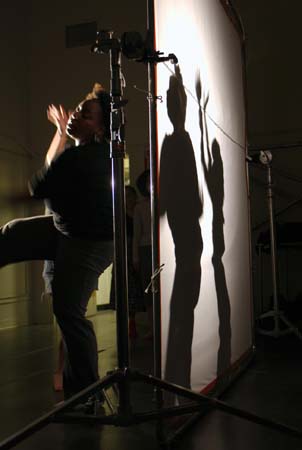
February 25 – 28, 2007: Davidson College
Sponsors:
Public Lectures Committee
Dean of Students Office,
Medical Humanities
Ethnic Studies
Gender Studies
Depts. Of Anthropology, English, History, and Theatre.
Classes Taught:
“Intro to literature: Reading Violence,” English Dept., Prof. Ann Fox
“Literary Analysis,” English Dept., Prof. Ann Fox
“Politics of Feminism,” Prof. Mary Thornberry
Performance/lecture: Feb. 28th
March 11 – 14, 2007: University of California – Berkeley
Classes Taught:
“Art, Medicine, and Disability.” Art Dept., Prof. Katherine Sherwood
“Exceptional Bodies: Disability, Race, Ethnicity and Medicine in American Cultures.” English Dept., Prof. Sue Schweik
Performance/Lecture: March 14
April 2 – 5, 2007: International Research Symposium,
University of Michigan – Ann Arbor
Global Ethnic Literatures Seminar
University of Michigan Initiative in Disability Studies
June, University of Washington, Seattle, performance at the Society for Disability Studies Conference
July 15 – 20, 2007: Collaborative Writing Residency
New Bern, North Carolina
Linke to Cyber Participant Instructions